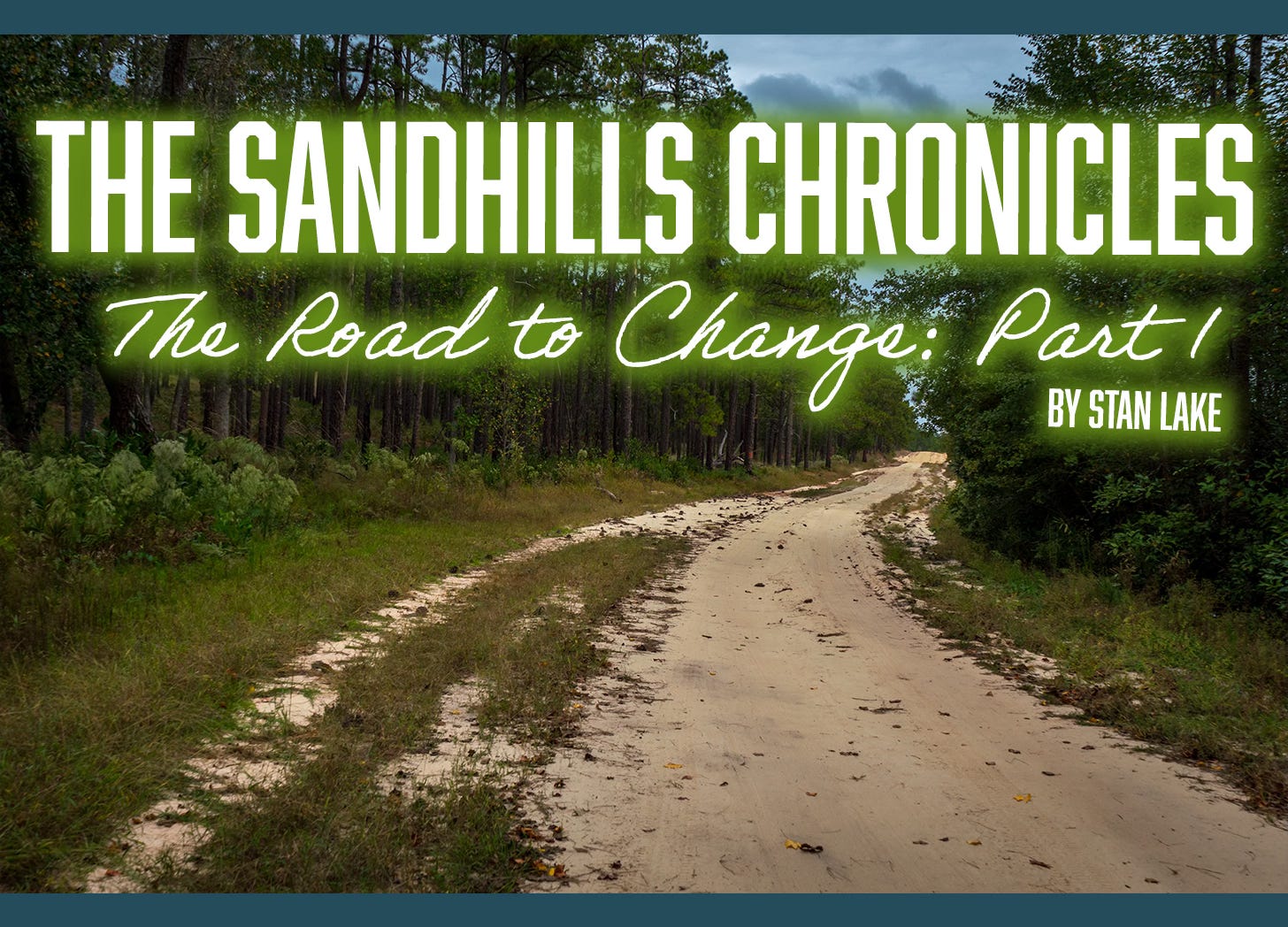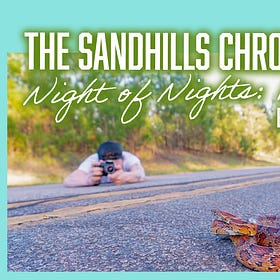On a road trip to the sandhills a few months after that night of nights, I had the opposite experience of that glorious adventure. I did a few aggressive U-Turns for corn leaves, pine needles, or patterned tree roots splayed in the middle of the highways while on my way to all of my favorite spots only to find…nothing. What I did find were other herpers out enjoying the area. Almost as soon as I turned off the main highway onto a sand-bottomed road, I saw a Subaru with South Carolina plates and “I brake for snakes” and other reptile-related bumper stickers on the back. “Great,” I said to myself. This was going to be one of “those days.” As it turned out, I ran into this gentleman about an hour later as I was lumbering out of the woods and he was driving by. It turned into a great conversation about the beauty of the sandhills and how much we loved the area and the animals that called this place home. As I made my maddening loops from spot to spot, I ran into quite a few other people that I recognized from one form of social media or another. We all seemed to be friends of friends sharing a similar passion for seeing endemic herps.
The highlight of my day was my time speaking to Brady Beck, a state biologist who works with a team of biologists, foresters, and technicians to manage the Sandhills game lands. This man has a passion for the sandhills, to say the least. We geeked out over camera gear and lamented how things have changed somewhat over time in the region. We tried to think of creative ways to both keep this place a secret and also illustrate its beauty so that it will be loved and protected by all. It’s that fine razor edge of loving a place without exploiting it. In many ways, I’ve learned these trips to the sandhills have less to do with the animals and often it’s about the people you meet along the way that make this place so amazing.
In the over Twenty years that I’ve been making road trips to and from this area, I’ve seen it change in dramatic ways. For example, the peach orchards that dotted many of the old backroads in the area have been converted to solar farms. My initial thought was that although this was done with green intentions, I wondered what impact it may have had on the endemic animals. I was, however, reminded that those peaches were outside invaders too. They were imported from Asia more than a century ago. The native longleaf pine habitat was cut down and removed to plant those orchards. The solar farms were just a new chapter in an already scarred landscape. Perhaps just the perceived beauty of the area and nostalgic cultural history had changed but as far as impact it was a neutral move. Time will tell. Many neighborhoods and businesses have seemed to spring up out of the sandy soil over the last handful of years. I both mourn the loss of old haunts and wonder how the new tenants will treat the native wildlife they will most certainly encounter. Is all progress bad?
With the popularity of the internet’s various communities over the last few decades, I’ve seen a rise in people coming from out of state to observe our wildlife. Some attach dollar signs to our natural bounty and poach declining species for high profits. I love the wildlife in this special place and I’ll fight for it, but I’ve often wondered about the impact we are having on the region as a whole. In October, for example, Hognose Snakes began to move. The month has been coined “Hogtober” on social media. This further draws people to the region for both good and bad. Some come to poach Southern Hognose and some come for Instagram clout. As we undoubtedly stalk these wonderful animals for whichever intent, how many rare plants are being trampled en route to the coveted snakes? Does our need to out Instagram our peers contribute to unscrupulous followers finding our spots and collecting these rare gems from the wild? Have we unwittingly opened up our favorite spots to disreputable herpers who may not share the ethics we do? These are all the questions I ask of my friends and myself as we set out on these road trips. Are we loving this place to death?
Will this make me stop taking these trips? No! But it does make me consider the ethics of it all. For example, when I post pictures, I do my absolute best not to stress the animal more than necessary. The goal is not to stress them at all but I imagine my mere presence as a potential predator elicits some level of stress to said animal. I try to crop in as close as I can on habitat shots and not show any identifiable features so as not to invite people to find out where exactly I am. In these sacred spots, I do my best not to allow my zeal to share pictures or videos of these wonderful creatures to trump my desire to conserve and protect their wellbeing.
I know it’s debatable but I don’t log information in any of the herp-related nature apps for that very reason, although I fully understand the scientific value of data collection in the region regarding citizen science for population density, etc. I am often more afraid that people will reverse engineer these sites to find and disturb these animals. Usually, when I’ve found something remarkable, I take note and send an email to the appropriate personnel at the state level and let them log the data their way. I guess I’m still old-school like that.
This is Part 3 of 4 of the Sandhills Chronicles
A version of this article was originally published in the Orianne Society’s Indigo Magazine Winter 2020 Issue
Read Parts 1 & 2 Linked Below:
The Sandhills Chronicles
Have you ever found a place where you feel at home? A place that seems to have infinite possibilities and mysteries around every corner? The North Carolina Sandhills is just such a place for me. I remember the first time I visited this hallowed ground in pursuit of reptiles and amphibians. I was around 18 years old and fresh out of high school and basic training in the US Army. My love affair with this region is also inextricably intertwined with the military. This is because the Army still uses the area for training.
The Sandhills Chronicles
The sun hadn’t even set yet but we had all the signs of an amazing adventure. We drove through the sunset stopping here and there for short hikes in search of our quarry with no luck. As the minutes turned to hours with nothing to show, it seemed we had gambled wrong. There was just nothing on the road. Until—magically—there was. We had almost lost hope in the success of our mission and then our luck changed for the good. Turning the corner on an old road with tufts of grass growing inside the broken asphalt, I yelled for Thomas to stop the vehicle. We slid on the loose pavement and I jumped out of the passenger door before the car had completely stopped.








Another great read. I’m so glad you take the time and effort to try and protect the species! I wish all were like you. I have learned so much and am grateful. Love always!